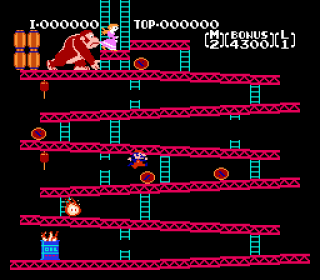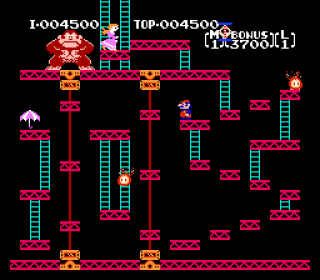Overview
 The First Level
The First LevelThe arcade classic Donkey Kong rose out of Nintendo's desire to crack into the United States arcade market. The company's president back in 1981, Hiroshi Yamauchi, made the decision to take a Nintendo arcade release called Radar Scope (a hit game in Japan that floundered in the States) and see if it could be easily retrofitted to play a different, and hopefully more successful, game. To accomplish this task, Yamauchi chose a young employee named Shigeru Miyamoto.
The basic story of the game is that Donkey Kong is Jumpman's pet. Jumpman mistreats Donkey Kong, who snaps and kidnaps Pauline and, in a decidedly King Kong-like twist, takes her up a building under construction. Jumpman must navigate four different levels, climbing to the top to either force Donkey Kong to move on or, in the stunning final confrontation, bring the building's girders down to make the big monkey fall.
Donkey Kong was followed-up by Donkey Kong Jr. , which puts the player in the role of Donkey Kong's son, Donkey Kong Jr., who must attempt to rescue his father from the clutches of the evil Jumpman, who by then had already been renamed Mario.
Development
 The Second Level
The Second LevelUpon going to work, Miyamoto's first attempt was to make a game based on the then-popular Popeye character. The licensing deal was not pursued by Nintendo, though the company would later secure the license and develop a popular Popeye arcade game. Miyamoto had to retrofit his concept and develop three characters with similar relations to Popeye, Olive Oyl, and Bluto. He came up with a little man with a mustache that was quickly named Jumpman, who had to save his girlfriend, Pauline, from the evil gorilla named Donkey Kong. After designing the concept Miyamoto approached his more colleague Gunpei Yokoi who would assist the young designer by supervising the technical development of the project.
Unfortunately due to the technical limitations in place not all of Miyamoto's ideas for the game were able to be included as concepts such as incorporating seesaws into the game or having the characters expressions more defined and animated were unable to be incremented into the game. These technical restrictions would ultimately have an effect on the character design of Jumpman as he was forced to make the character small whilst still making him look human. As such Miyamoto thought it best to give the character distinct features,
"such as giving him a big nose. We gave him a moustache so that we didn't need to draw a mouth, as it's often difficult to show facial expressions with small characters. We also gave him big hands."
The name Donkey Kong was ultimately the decision of Miyamoto too. Wanting to give the impression of a stubborn, stupid gorilla he thought of animals which he thought were dim-witted and stubborn he came up with the idea of 'Donkey' which he believed to mean stupid. He also wished to incorporate the word 'Kong' into the title which in Japanese gives the idea of apes. Putting the two together the end result was "Donkey Kong".
Legacy
 The Final Level
The Final LevelDonkey Kong helped to create the platformer genre, and also was one of the first to include a story. Donkey Kong changed the way people played games; no longer was it just about high scores, gamers began to play the game to find out what would happen next. Donkey Kong became one of the most iconic video games of all-time and a huge part of American pop culture, gaining mentions on countless television shows, songs, and movies. Donkey Kong also essentially launched Nintendo's biggest character of all-time, Mario.
As a testament to the legacy of Donkey Kong, the documetary King of Kong: A Fistful of Quarters was released in 2007, 26 years after the game's debut. The film was about gamer Steve Wiebe and his journey to defeat Billy Mitchell's high score, which had stood for 25 years. Public awareness about the competition for this score was raised by this film, and in the years since Wiebe, Mitchell, and others have traded positions on the top spot. Read more about the documentary at the official site.
In July 2009, Donkey Kong made news yet again when a 26-year-old easter egg, which did nothing more than display the initials of Landon M. Dyer, who worked to code the title, was uncovered after Dyer mentioned that he had forgotten how to display the initials and offered $75 to whomever can find the Easter egg first. The $75 was awarded to Don Hodges after he dug through the game's code and found the way to display the initials.
Donkey Kong: Original Edition
In 2010, a special version of the NES release of Donkey Kong was available to those in Europe who purchased the special Super Mario Bros. 25th anniversary Wii. This version, subtitled "Original Edition", restored the missing "pie factory" stage as well as some animations. Although still not arcade-perfect, it was still much more than any edition released on the NES.
This edition of the game would not release in Japan or the United States until 2012, and only then, on the 3DS. In Japan, it was a pre-order bonus for New Super Mario Bros. 2. In The States, it is a bonus gift for players that purchase the digital download versions of Art Academy: Lessons For Everyone!, Paper Mario: Sticker Star, Professor Layton and the Miracle Mask, Style Savvy: Trendsetters, or Crosswords Plus before January 6, 2013. It was made available to everyone for purchase on the European 3DS eShop on September 18, 2014.
Trivia
The first console port was licensed by Nintendo but not made by them. A near perfect arcade port, and pack-in, was created for the ColecoVision system. This propelled its sales over the Atari 5200 and sold 500,000 units at launch. Over a year later Coleco made a version for its rival's Atari 2600. Sega was also planning to release a version with Coleco.
Falcon was licensed to distribute the game in Europe, which it did so with modified graphics and the name "Crazy Kong" (this is often mistaken to be a bootleg game). They did the same with the sequel Donkey Kong Junior, as Crazy Kong Jr./Crazy Junior.
Log in to comment